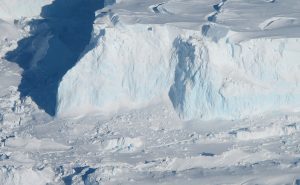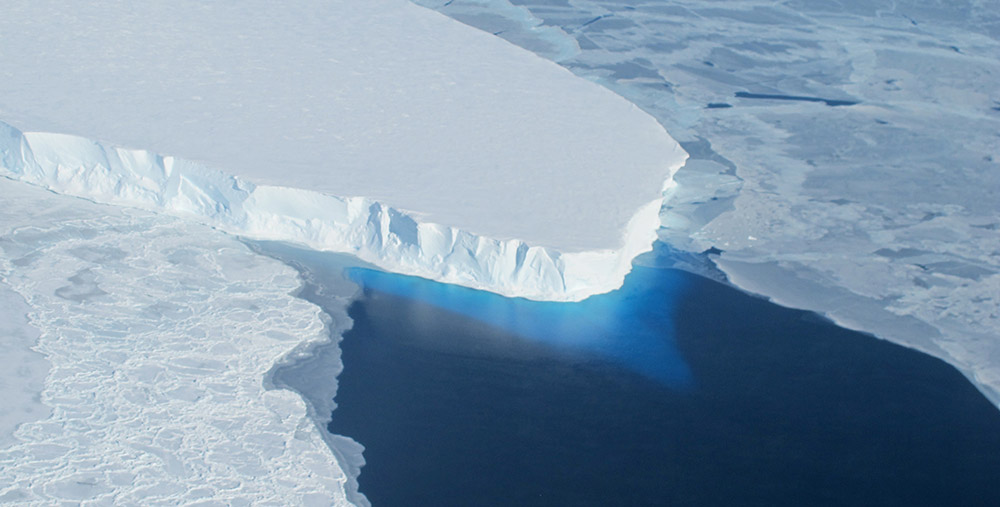Imminent disintegration: One of West Antarctica’s largest glaciers is in grave danger and could lose an important “brake” in the next few years, according to researchers. Because the floating part of the Thwaites Glacier crisscrosses the fissures and threatens to separate itself from its anchor in the form of an underwater mountain. When this happens, the ice can flow unchecked into the sea and much of the glacier collapses.
The Thwaites Glacier in West Antarctica is one of the largest glaciers in the region. The glacier front has a width of 120 meters and its area corresponds to the area of u200bu200bthe whole of Great Britain. The volume of ice in it is large enough to raise sea level by 65 cm when the ice is completely thawed. Because it also slows the flow of neighboring glaciers such as cork, its collapse could sweep away much of the West Antarctic ice.

That’s why, among other things, the Thwaites glacier has been under intense monitoring for so long – and the observations don’t bode well so far. Researchers have found that the glacier is increasingly being swept away by warm sea water, which has melted huge caverns of ice on its underside. In addition, the glacial current is flowing faster and faster toward the sea: “It has doubled the speed of its outflow in the past 30 years,” reports Ted Schampos of the University of Colorado.
Icy loses its “brakes”
Now there’s more bad news, as scientists from the Thwaites Glacier Collaboration International (ITGC) report. According to this, there are many cracks in the eastern ice shelf of the glacier flow – the floating part of the ice tongue that was previously held by the underwater ledge. Now the ice shelf near this “anchor” threatens to collapse and the last one could lose control, the research team warns.
“You can think of it as a windshield that has a few cracks that are slow to spread at first,” explains glaciologist Erin Pettit of Oregon State University. “Then you drive over a hump and suddenly everything collapses everywhere.” If this happened to the Thwaites glacier, the ice would flow into the sea three times faster than before – and could sweep away part of the surrounding glaciers.
Cracks in the eastern part of the glacier are getting longer by several kilometers each year and increasingly reaching thinner and more fragile ice, the team reports. Tensions in the ice there have also increased significantly in recent years. This could lead to the collapse of this part of the ice shelf within the next five years, Pettit reports.
The researchers from the Thwaites Collaboration report their findings.© AGU
Strong baseline and tidal pump
The situation at the Thwaites glacier’s baseline looks similarly worrisome – the area in which the ice flow breaks off from the ground and begins to swim. A team led by Peter Washam of Cornell University maneuvered a remote-controlled diving robot through an ice hole in this region of the glacier. The resulting images show that the lower side of the glacier has already been severely attacked there: the ice has been severely cracked and melted by the warm sea water.
Other measurements revealed why: The seawater flowing into the lower side of the glacier is unusually warm and salty by polar standards. This speeds up the defrosting process from the bottom side of the ice. This effect does not stop at the glacier’s baseline, another team led by Lizzie Klein of Lewis and Clark College found. They investigated the effect of tides on subglacial water currents.
The result: Because the entire tongue of the glacier rises and falls slightly due to the ebb and flow of the tides, this acts as a giant pump on the glacier’s underside. Each rise of the glacier separates its lower side from the baseline and creates an absorption that transports warm water kilometers downstream. As a result, the Thwaites glacier is also melting from below in the part that has not yet floated.

An elevated ice front can lead to a chain reaction
And something else threatens the stability of the Thwaites glacier: As with many glacial flows in West Antarctica, the soil in the last part of its bottom does not slope towards the sea, but sinks inward. As a result, the thickness of the ice increases sharply inland from the baseline. As the ice front recedes more and more, the breaking edge of the ice becomes higher and higher.
As a result, the ice edge and thus the glacier front is becoming more and more unstable, Anna Crawford of the University of St Andrews in Scotland and colleagues decided with the help of models. These results show that when the glacier loses the ice shelf in front of it and the ice front becomes higher and higher, the forces of the flowing ice act more and more on the ice shelf and cause it to break more and more. In extreme cases, this can trigger a chain reaction that causes the ice flow to break down faster and faster, Crawford reports.
“If that happens and the Thwaites glacier collapses, it will take most of the West Antarctic ice with it,” Scampos says. This could raise sea level by as much as 2.40 metres. It is very important to continue to closely monitor and research the behavior of this glacier. (American Geophysical Union (AGU) Fall 2021 meeting)
Those: CIRES / University of Colorado




More Stories
Nvidia GeForce RTX 4090: AIDA64 gets Ada spearhead support
Rogue Trader – Details about the first cRPG in the series – CD-Action
t3n – Digital Pioneers | digital business magazine